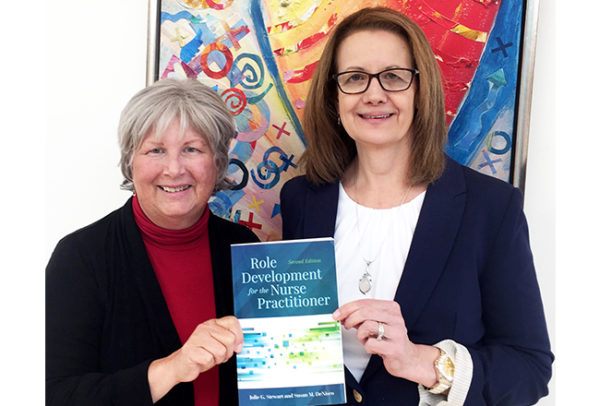Eight years ago, Julie Stewart and Susan DeNisco, both professors at Sacred Heart University”™s College of Nursing, saw the publication of their textbook “Role Development for the Nurse Practitioner.” In the ensuing years, the professors realized that this would not be a one-off happening.
“In almost every field, when you get something published, you wind up with more issues to add to the book,” said Stewart.
In January, Stewart and DeNisco”™s publisher, Jones & Bartlett Learning, released the second edition of “Role Development for the Nurse Practitioner.” The second edition offers new chapters on topics including electronic health records and global health issues, as well as an in-depth consideration of what the authors described as “vulnerable populations.”

“We look at populations that are medically underserved, disenfranchised and marginalized: the homeless, immigrants, migrants, transgendered individuals,” said DeNisco, who added that nursing and health care needs to adapt to shifts in the population. “The demographics of our world are changing. In the U.S., minorities will outnumber the majority by 2040, and there will be more elderly than children.”
Stewart also pointed out that the new edition offers updated considerations on the role that adverse childhood events play in adult health. “It is not only something we usually think of, such as depression and anxiety, but it can also can impact cancer, heart disease and asthma,” she said.
Designed to help students in their transition from the role of registered nurse to nurse practitioner, “Role Development for the Nurse Practitioner” covers both the history of the
nurse practitioner profession to a contemporary consideration of topics including unique practice theory, clinical evaluation and presenting a patient case to the preceptor. Stewart noted that nurse practitioner students aiming for graduate and doctorate degrees had previously needed to acquire articles from various journals and chapters from different textbooks to cover the subjects required for their coursework.
“I thought students need to have one source to access,” said Stewart, who first proposed the idea for the book to DeNisco.
Stewart admitted that the year-long creation of the book “wasn”™t as easy as I thought it would be,” but she added that she enjoyed partnering with DeNisco on the project. “It was a pleasure to work with someone you know well,” she said. “We all have ups and downs, ebbs and flows in life, and it is important to know there is someone who can pick up the work if something goes on in the other”™s life.”
The first edition of “Role Development for the Nurse Practitioner” resulted in a five-star review from Doody’s Review Service, a clinical information database. And while Stewart and DeNisco may not rival J.K. Rowling for book sales ”“ Stewart admitted the book”™s audience was a “small target group” ”“ they found themselves enjoying praise within their field.
“I”™ve gone to conferences with other nurse practitioner faculty and they say, ”˜Oh, we love your book and use your book,”™ Stewart said.
“The students enjoy having a textbook written by their faculty,” said DeNisco.
While promoting their new work, both professors have their own writing projects underway, with DeNisco readying a fourth edition of the textbook “Advanced Practical Nursing” and Stewart writing “Family Nurse Practitioner Certificate Review.” However, they admit that “Role Development for the Nurse Practitioner” holds a special place for them.
“We love the book,” DeNisco acknowledged. “We think it is our favorite textbook.”






















Comments 1